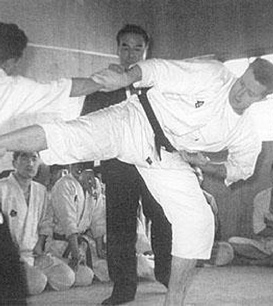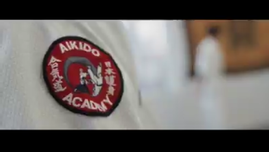
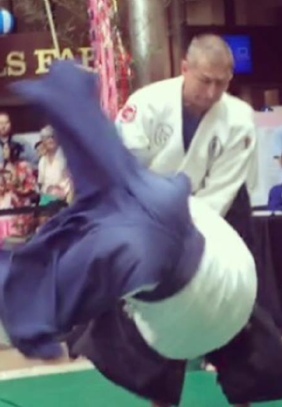
Inside Nihon Goshin Aikido ~ #71
May 2019
Inside This Edition:
- Special Training Opportunity with Shihan Bowe in May
- Being a “Good” Bad Guy
Greetings Nihon Goshin Aikido Aficionados!
It's May, and later this week I'll be headed up to Middletown, NY to train with Sensie MacEwen and Mr. Bowe at the class on Saturday. Exciting times!
Onward.
Aikido ~ NGAexperience.com's "The Official Uke Follow Me Guide: How to Be a 'Good' Bad Guy."
Part 3 of 6:
Beginning a few months ago , I began a series of articles discussing the aspects that all good ukes should manifest. The aim of every Uke is to be a "good" bad guy ~ we hope to highlight actions that promote good uke behavior in this ongoing series.
Watch almost any generic aikido video you see on youtube, and it will typically be saturated with what I define as generally "unnatural" uke behavior. Now let me be clear, I am not being critical of the act of Aikido ukemi ~ the falls and rolls ~ or the act of receiving the technique. The falls are great ~ if not spectacular. When I reference unnatural uke behavior, I am referencing the simple fact that the attacking intention of uke is typically negligent in many respects ~ if not possibly even non-martial in many training scenarios and demos.
"Good" Bad Guys don't have to strike with lethal intentions, but every strike should have these qualities:
1) The strike should be on target (Covered in the March 2019 edition of the newsletter),
2) The strike should be delivered with a closed fist, as opposed to an open hand (Covered in the April 2019 edition of the newsletter),
3) The strike should be delivered with uke's conviction to stay in the fight (not tossed out there and immediately followed by a self inflicted flop onto the mat),
4) The striker should always seek a combination punch (in other words uke's non striking hand should be kept martial throughout nage's technique),
5) The uke should look for a way to counter nage's technique,
6) Uke doesn't need to say anything between attacks ~ just train,
This month we are considering Quality #3 ~ namely that Uke's strike should be delivered with the conviction to stay in the fight, and not tossed out there and immediately followed by a self inflicted flop onto the mat.
Now let me say up front that there is sometimes great wisdom in the throw and flop strategy. As we all agree, in Nihon Goshin Aikido we train realisticlly. The aim of what we are doing in the dojo is designed to mimic realistic attacks on the street. As I have said before, it seems to me that there are zero instances of real fights posted on youtube where someone attacks someone else with a shomenuchi (chop to the front of the head) or yokemunch (chop to the side of the head) ~ see examples to the left. Have you ever seen anyone attack like that?
So because we are throwing realistic punches, everything coming after that punch is quicker. Furthermore, all the time spent on the Classical Techniques which are designed to maximize the effectiveness of our applications means that the techniques are applied with precision, the locks are tight, and the reversals are dynamic. You can see where this leading right? Because of the way we train, the chance of injury is potentially much higher than if you trained in other Aikido styles where things are slower and less martial.
I once did Pivot Take Down (Shihonage) on an aikido practitioner from another style, and he was amazed at the power I generated from in the Pivot. He told me, "That's the way our Shihans do it." Of course, I'm no Shihan, and in fact, I think I was a 1st kyu/ brown belt at the time. Lol This is a reflection on Shodo Morita, Soke’s skill. He was the model of effectiveness, so everyone who trains in our style has a link to that same devastation. More so, when Mr. Bowe went to Japan he already had a teaching certificate (black belt) from Sigwald's School ~ which trained a style loosely referred to as "combat Judo." Mr. Bowe knew what he was looking for in a martial art. He had a significant understanding in martial training ~ especially considering that it was in the late 1950s. He has stated multiple times that after surveying many of the Japanese Martial Arts (including the Aikikai) in Japan, he was amazed at how easily Master Morita's slightly built Japanese students could throw him (a muscular, 6'4" American).
My point is that our style works, so it is with some self interest and self preservation that our ukes flop at the first sign of danger.
Consider this anecdote: In the past when I would work with newer students on the Come Along Throw, I used to always ask, "Do you have a prior or current shoulder injury?" If they answered "No" ~ I'd often reply, "Well, you will if this technique is applied on you and you fail to roll out of it immediately." So here I am telling students to do the exact thing we don't wan them to do: namely "Flop!" Furthermore, I'd argue for good reason, but how do we get out of the flop mentality once we've established a very good reason for it in the minds of our ukes?
I think the answer may be found in the incorporation of some connection training exercises. If you remember the old game of "hot hands" you may be able to anticipate where I'm going, but this game is much more friendly.
The rules of the Connection Training game:
Uke grabs nage's wrist with either a straight or cross grab. The pressure of uke's grip should be something akin to a firm handshake. Uke's job is to adjust his positioning in order to maintain the strength of that grip at all times.
Nage's intention is to slowly move through a series of Classical Techniques without finishing any of them, paying close attention to uke's grip pressure. In other words, uke does whatever he has to do to hang on to nage's wrist, and nage runs through a series of Classical Techniques adjusting the speed of his movement so that uke does not lose connection. Stated another way the goal of the Connection Training Game is for nage to move through the series of techniques as fast as uke will allow him to do so (*without uke losing the strength or position of his grip). Both parties are working on maintaining that grip.
Here are a few selections you might enjoy experimenting with when you work on the Connection Training Game.
From a Straight Grab:
Series 1: Unbendable Arm => Wheel Throw => Hand Shake => Arm Bar
Series 2: Lift
Up => Pivot Take Down => Spin Around => Reverse Pivot Take Down
Series 3: Third Set Wrist Technique => Handshake => Over the Back Throw
Here's a Cross Grab series to get you started:
Pull Down from the Rear => Spin Around => Reverse Pivot Take Down (fail) => Front Wrist Throw
Can you come up with a series of two from a Cross Grab?
Notes:
1. The last technique in the chain is always finished to completion. If the last technique does not end in a controlled pin, nage should transition to a controlled pin after the final technique if possible.
2. Uke should be moving around nage to maintain his grip. Nage's position is not static, but is certainly central. You will know you are doing it correctly as nage if you feel like you are the eye in a hurricane, and your uke is the wind circulating around you.
3. Also note that nage can just "move" from his one point and force uke to follow without cycling through any techniques. What must uke do to maintain the strength of his grip if nage executes an Irimi blend?
My thought is that devoting a percentage of open mat training time to Connection Training will sensitize the all important connection between nage and uke. If uke is not connected to nage, there is a risk of injury to uke if nage completes a technique ~ and because we are often not connected, we tend to flop. Over time, nages might develop better pacing so they are not too far ahead of uke, uke's might develop better anticipation. Surely trust can develop, and eventually uke's "flop" instinct may be curtailed.
In next month's newsletter, I'll discuss the 4th good quality of all good ukes, which will make the connection exercises described here even easier. What is the 4th quality all good ukes must have? Namely: the uke should always be seeking to land a combination punch ~ at every point of nage's technique.
Click Here for A Random Archived "Inside Nihon Goshin Aikido" Newsletter Edition
Mystery Articles of Interest
If you are planning on training with Mr. Bowe on the 18th in Middletown, NY, I look forward to seeing you there. If not, let's meet together on the mat and soon.All the best,
Jonathan Wilson
Ngaexperience.com
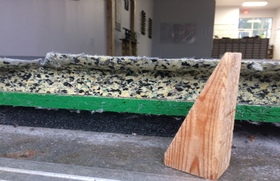
This is a cross section of the Aikido of Charlotte training mat Take a Close Look!
The Formula:
Bottom Layer: 1.5 inch closed cell foam blocks.
Middle Layer: 0.75 inch sub-flooring
Top Layer: 1.5 inch Zebra mat
This Should Be the Standard for all Aikido Flooring Systems.
Make it Happen!
This guy’s aikido makes me smile. This is what my Aikido looks like.

Unless otherwise stated, the author’s views, musings, and opinions do not necessarily reflect the attitude of leadership within any of the various Nihon Goshin Aikido associations, or unaffiliated Nihon Goshin Aikido dojos.
2014 - 2021 ngaexperience.com
Aikido's Hidden Ground Techniques Video Trailer
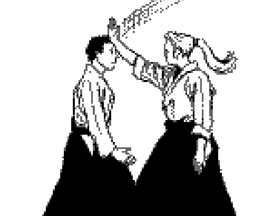
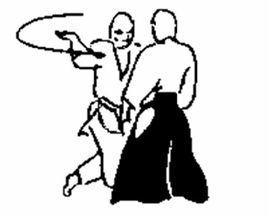
The Shomenuchi ~ one Slow Engagement
The Yokomenuchi is even slower and equally non- martial.
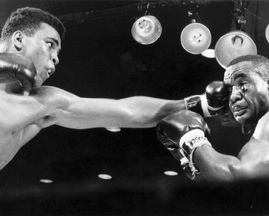
The Jab is not slow.
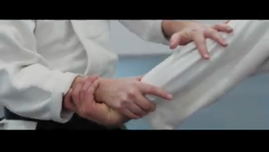
Want a Solid Arm Bar?
1. Ki Finger of Gripped hand Extended
2. Shuto Driving Fulcrum Just Above Elbow
3. Power from Tenkan Hip Pivot Driving Uke Off His Base and to the Ground

